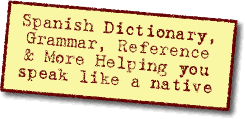Ask a Question(Create a thread) |
|
|||||||
Noun and Adjective OrderThis is the place for questions about conjugations, verb tenses, adverbs, adjectives, word order, syntax and other grammar questions for English or Spanish. |
 |
|
|
Thread Tools | Display Modes |
|
#1
|
|||
|
|||
|
Noun and Adjective Order
In Spanish do adjectives always follow nouns? Are there exceptions?
Would I call a blue whale "ballena azul" or "azul ballena"? Also, I've seen some gender variations with animals. Is this universal? If the whale was a male would it be "balleno"? While I'm at it what is the word order for verbs and adverbs? I hope these questions are not too simple. I just started trying to learn about a week ago. |
|
Get rid of these ads by registering for a free Tomísimo account.
|
|
#2
|
||||
|
||||
|
A too much wide topic, indeed.
As a general rule, adjectives follow nouns. This is true some 90% of the times. This order is not 100% rigid as Spanish is very flexible in terms of word order as long as you don't scramble clauses. About your examples, the problem is azul being both a noun and an adjective, so they are read in a noun-adjective order: ballena azul (a whale that happens to be bluish) azul ballena (a shade of blue that is somewhat associated with whales) As you can see, ballena is only a noun, but it can be used as an adjective in certain conditions. But you change the meaning by adding the article: La ballena azul (same as ballena azul) El azul ballena (same as azul ballena) La azul ballena (almost the same as ballena azul) Too much hidden in a "simple" case so let's look for other examples: árboles grandes this is the "normal" order, because an adjective following the noun is specifying and defining what type it is: big trees as opposed to small ones or mid-size ones. grandes árboles this is a less common order, because an adjective preceding the noun is qualifying the whole noun: Los árboles grandes del parque (the big trees among all the trees in the park) Los grandes árboles del parque (the trees in the park, that happen to be big as a general rule) Too complicated? Don't dismay! Even for native speakers is enough to stick to a noun-adjective order and add any additional comment you need to be as specific as you want.
__________________
[gone] |
|
#3
|
|||
|
|||
|
Some animals have always the same gender, other not.
Ballena, antílope, gacela, águila, rata... Perro/perra, gato/gata, león/leona, cerdo/cerda... Sometimes they take different names: Gallo/gallina, caballo/yegua, toro/vaca...
__________________
Corrections always very welcome 
|
|
#4
|
|||
|
|||
|
Thank you for your responses.
It is still very complicated to me, but I imagine it will get easier with persistence. |
|
#5
|
||||
|
||||
|
Adding some other observations:
As aleC says, most adjectives normally follow their nouns. Many of them can be placed before their nouns instead, but usually the movement adds an extra nuance. The most-likely nuance depends partly on the particular combination of noun and adjective and partly depends on the larger context. The most common types of added nuance are: 1. The normal position (after the noun) is a more concrete meaning, while the marked position (before the noun) has a more figurative meaning. The particular figurative meaning is not always predictable. Common examples include: "el chico pobre" = the poor (penniless) boy "el pobre chico" = the poor (unfortunate) boy "el hombre grande" = the large man "el gran hombre" = the great/important/famous man 2. The normal position (after the noun) usually (though not always) serves to distinguish the particular instance of the noun from others of its class that do not have the characteristic. The marked position (before the noun) is more likely to merely describes an innate characteristic of the noun, rather than distinguish it from other instances. For example: "la comida rica (de los que sirvió)" = the tasty/rich food/dish (from those that he/she served) [possibly a particular dish among several] "la rica comida (del restaurante)" = the tasty/rich food/meals (of the restaurant) [all of the food that the restaurant prepares is tasty/rich] |
 |
«
Previous Thread
|
Next Thread
»
| Link to this thread | |
|
|
|||||||
 Similar Threads
Similar Threads
|
||||
| Thread | Thread Starter | Forum | Replies | Last Post |
| Adjective + que + noun/subject pronoun + subjunctive/infinitive | laepelba | Grammar | 10 | February 28, 2012 01:10 PM |
| De between noun and adjective | QueenT26 | Vocabulary | 4 | September 10, 2010 03:36 AM |
| Noun + de/a + verb | pogo | Grammar | 6 | November 12, 2009 01:45 AM |
| adjective noun order | pogo | Grammar | 5 | October 03, 2007 01:15 PM |
All times are GMT -6. The time now is 12:05 PM.







 Linear Mode
Linear Mode

